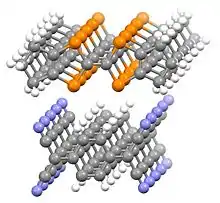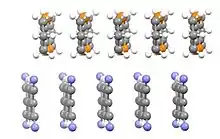Charge-transfer complex
A charge-transfer complex (CT complex) or electron-donor-acceptor complex is an association of two or more molecules, in which a fraction of electronic charge is transferred between the molecular entities. The resulting electrostatic attraction provides a stabilizing force for the molecular complex. The source molecule from which the charge is transferred is called the electron donor and the receiving species is called the electron acceptor.

The charge-transfer association occurs in a chemical equilibrium with the independent donor (D) and acceptor (A) molecules:
Examples
Electron donor-acceptor complexes
A number of organic compounds form electron-donor-acceptor complexes (EDA complexes). Typical acceptors are nitrobenzenes or tetracyanoethylene. The strength of their interaction with electron donors correlates with the ionization potentials of the components. For TCNE, the stability constants (L/mol) for its complexes with benzene derivatives correlates with the number of methyl groups: benzene (0.128), 1,3,5-trimethylbenzene (1.11), 1,2,4,5-tetramethylbenzene (3.4), and hexamethylbenzene (16.8).[2]
1,3,5-Trinitrobenzene and related polynitrated aromatic compounds, being electron-deficient, form charge-transfer complexes with many arenes. Such complexes form upon crystallization, but often dissociate in solution to the components. Characteristically, these C-T salts crystallize in stacks of alternating donor and acceptor (nitro aromatic) molecules, i.e. A-B-A-B.[3]
Iodine-starch complex
Iodine is a highly polarizable electron acceptor that forms C-T complexes with many donors. This interaction has been quantified and is the basis of many schemes for parameterizing donor and acceptor properties, such as those devised by Gutmann, Childs,[4] Beckett, and the ECW model.[5]
A well-known example is the complex formed by iodine when combined with starch, which exhibits an intense blue charge-transfer band. Many planar organic molecules form C-T salts.
The intensity of charge-transfer bands in the absorbance spectrum is strongly dependent upon the degree (equilibrium constant) of this association reaction. Methods have been developed to determine the equilibrium constant for these complexes in solution by measuring the intensity of absorption bands as a function of the concentration of donor and acceptor components in solution. The Benesi-Hildebrand method, named for its developers, was first described for the association of iodine dissolved in aromatic hydrocarbons.[6]
For example, the classic example of a charge-transfer complex is that between iodine and starch to form an intense purple color. This has widespread use as a rough screen for counterfeit currency. Unlike most paper, the paper used in US currency is not sized with starch. Thus, formation of this purple color on application of an iodine solution indicates a counterfeit.
TTF-TCNQ: prototype for electrically conducting complexes

In 1954, charge-transfer salts derived from perylene with iodine or bromine were reported with resistivities as low as 8 ohm·cm.[3] In 1973, it was discovered that a combination tetracyanoquinodimethane (TCNQ) and tetrathiafulvalene (TTF) was shown to form a strong charge-transfer complex, henceforth referred to as TTF-TCNQ.[8] The solid shows almost metallic electrical conductance and was the first discovered purely organic conductor. In a TTF-TCNQ crystal, TTF and TCNQ molecules are arranged independently in separate parallel-aligned stacks, and an electron transfer occurs from donor (TTF) to acceptor (TCNQ) stacks. Hence, electrons and electron holes are separated and concentrated in the stacks and can traverse in a one-dimensional direction along the TCNQ and TTF columns, respectively, when an electric potential is applied to the ends of a crystal in the stack direction.
Superconductivity is exhibited by tetramethyl-tetraselenafulvalene-hexafluorophosphate (TMTSF2PF6), which is a semi-conductor at ambient conditions, shows superconductivity at low temperature (critical temperature) and high pressure: 0.9 K and 12 kbar. Critical current densities in these complexes are very small.
Mechanistic implications
Many reactions involving nucleophiles attacking electrophiles can be usefully assessed from the perspective of an incipient charge-transfer complex. Examples include electrophilic aromatic substitution, the addition of Grignard reagents to ketones, and brominolysis of metal-alkyl bonds.[9]
See also
- Organic semiconductor
- Organic superconductor
- Exciplex - a special case where one of the molecules is in an excited state
Historical sources
- Y. Okamoto and W. Brenner Organic Semiconductors, Rheinhold (1964)
- H. Akamatsu, H. Inokuchi, and Y.Matsunaga (1954). "Electrical Conductivity of the Perylene–Bromine Complex". Nature. 173 (4395): 168–169. Bibcode:1954Natur.173..168A. doi:10.1038/173168a0. S2CID 4275335.CS1 maint: multiple names: authors list (link)
References
- Rather, Sumair A.; Saraswatula, Viswanadha G.; Sharada, Durgam; Saha, Binoy K. (2019). "Influence of molecular width on the thermal expansion in solids". New Journal of Chemistry. 43 (44): 17146–17150. doi:10.1039/C9NJ04888J.
- Foster, R. (1980). "Electron Donor-Acceptor Complexes". The Journal of Physical Chemistry. 84 (17): 2135–2141. doi:10.1021/j100454a006.
- Goetz, Katelyn P.; Vermeulen, Derek; Payne, Margaret E.; Kloc, Christian; McNeil, Laurie E.; Jurchescu, Oana D. (2014). "Charge-Transfer Complexes: New Perspectives on an Old Class of Compounds". J. Mater. Chem. C. 2 (17): 3065–3076. doi:10.1039/C3TC32062F.
- Childs, R.F; Mulholland, D.L; Nixon, A. (1982). "Lewis acid adducts of α,β-unsaturated carbonyl and nitrile compounds. A nuclear magnetic resonance study". Can. J. Chem. 60 (6): 801–808. doi:10.1139/v82-117.
- Vogel G. C.;Drago, R. S. (1996). "The ECW Model". Journal of Chemical Education. 73 (8): 701–707. Bibcode:1996JChEd..73..701V. doi:10.1021/ed073p701.CS1 maint: uses authors parameter (link)
- H. Benesi, J. Hildebrand, A Spectrophotometric Investigation of the Interaction of Iodine with Aromatic Hydrocarbons, J. Am. Chem. Soc. 71(8), 2703-07 (1949) doi:10.1021/ja01176a030.
- D. Chasseau; G. Comberton; J. Gaultier; C. Hauw (1978). "Réexamen de la structure du complexe hexaméthylène-tétrathiafulvalène-tétracyanoquinodiméthane". Acta Crystallographica Section B. 34 (2): 689. doi:10.1107/S0567740878003830.
- P. W. Anderson; P. A. Lee; M. Saitoh (1973). "Remarks on giant conductivity in TTF-TCNQ". Solid State Communications. 13 (5): 595–598. Bibcode:1973SSCom..13..595A. doi:10.1016/S0038-1098(73)80020-1.
- Kochi, Jay K. (1988). "Electron Transfer and Charge Transfer: Twin Themes in Unifying the Mechanisms of Organic and Organometallic Reactions". Angewandte Chemie International Edition in English. 27 (10): 1227–1266. doi:10.1002/anie.198812273.
